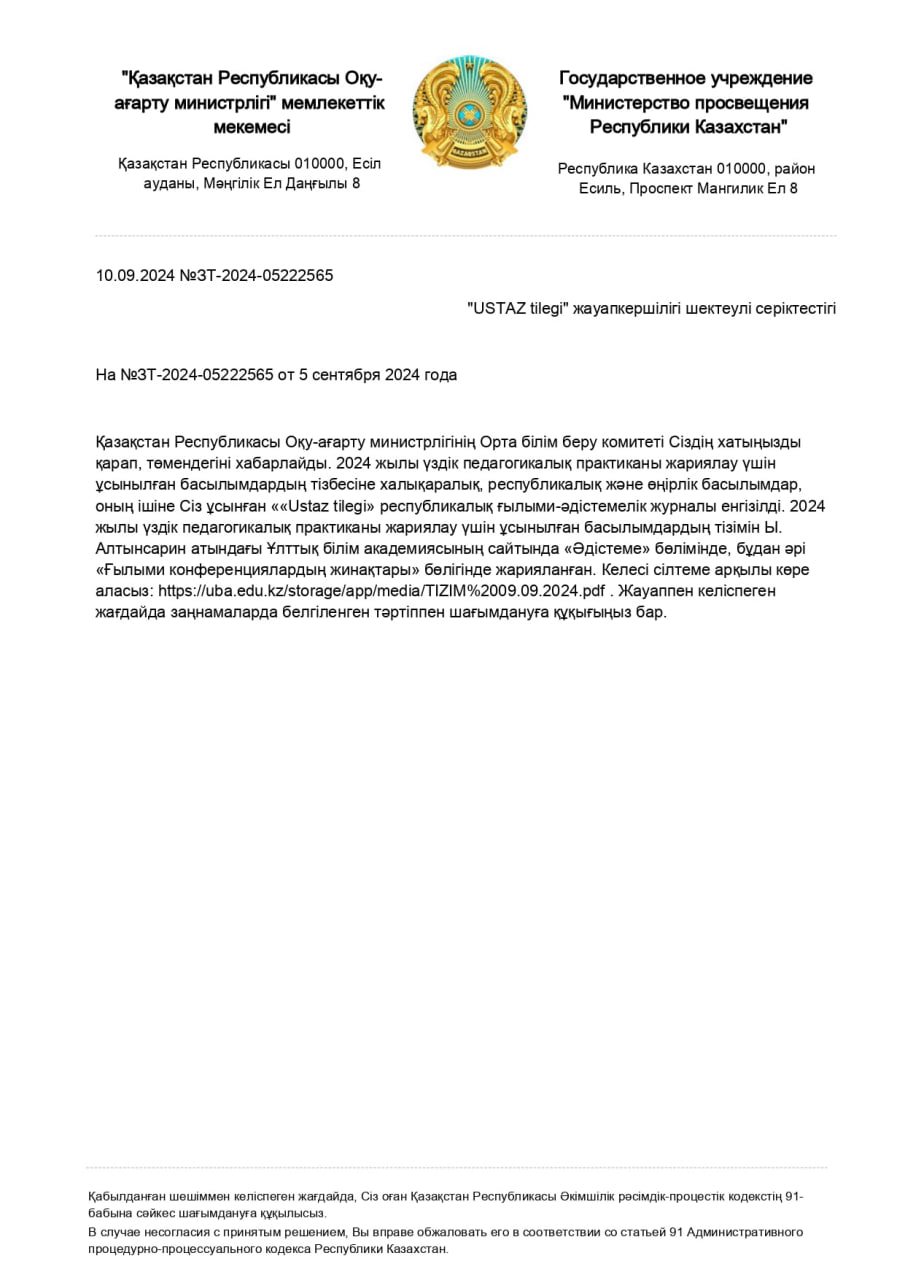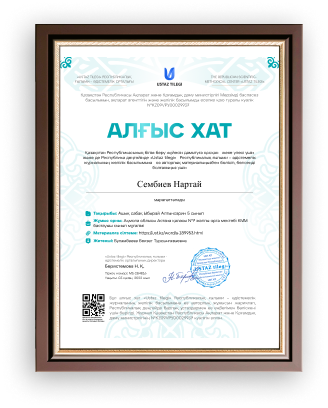ашық сабақ
ашық сабақ
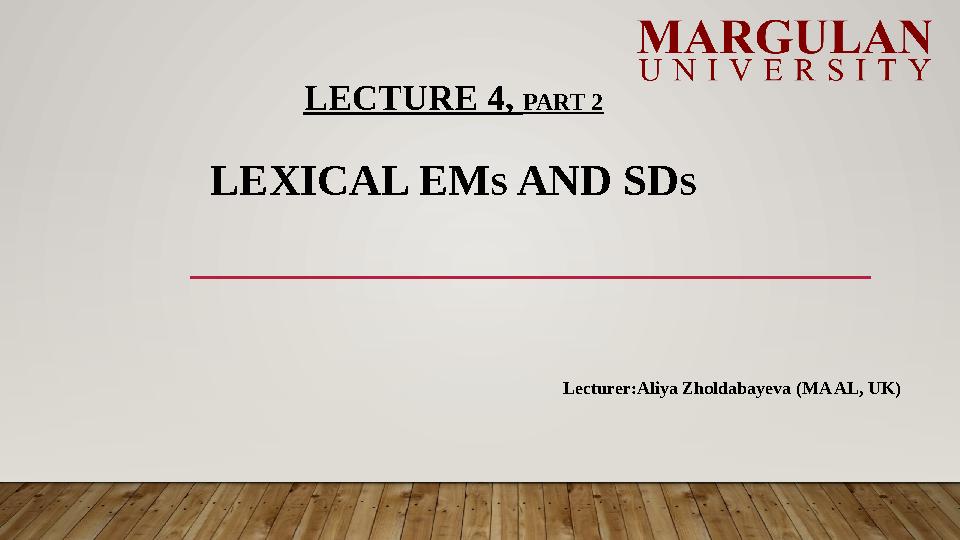

#1 слайд
LECTURE 4, PART 2
LEXICAL EMS AND SDS
Lecturer:Aliya Zholdabayeva (MA AL, UK)
1 слайд
LECTURE 4, PART 2 LEXICAL EMS AND SDS Lecturer:Aliya Zholdabayeva (MA AL, UK)
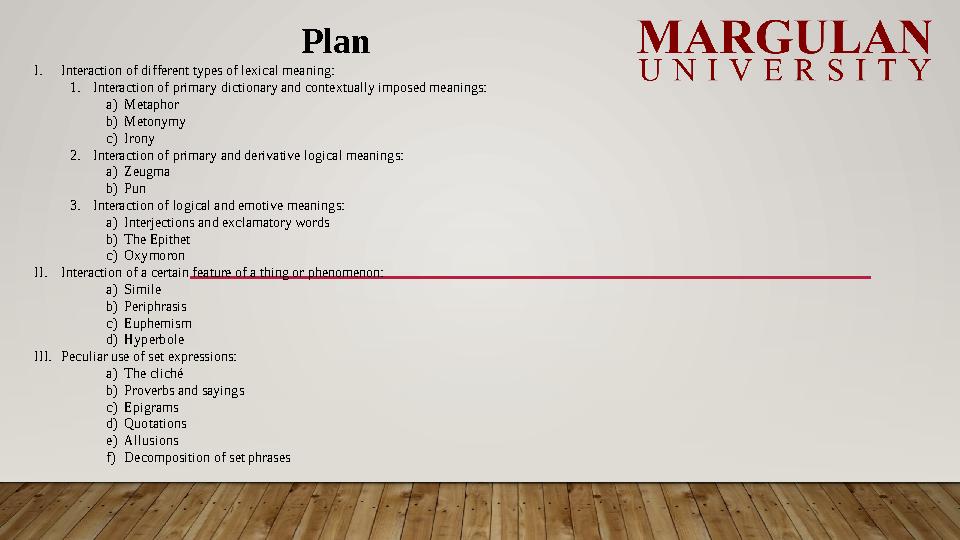
#2 слайд
Plan
I.Interaction of different types of lexical meaning:
1.Interaction of primary dictionary and contextually imposed meanings:
a)Metaphor
b)Metonymy
c)Irony
2.Interaction of primary and derivative logical meanings:
a)Zeugma
b)Pun
3.Interaction of logical and emotive meanings:
a)Interjections and exclamatory words
b)The Epithet
c)Oxymoron
II.Interaction of a certain feature of a thing or phenomenon:
a)Simile
b)Periphrasis
c)Euphemism
d)Hyperbole
III.Peculiar use of set expressions:
a)The cliché
b)Proverbs and sayings
c)Epigrams
d)Quotations
e)Allusions
f)Decomposition of set phrases
2 слайд
Plan I.Interaction of different types of lexical meaning: 1.Interaction of primary dictionary and contextually imposed meanings: a)Metaphor b)Metonymy c)Irony 2.Interaction of primary and derivative logical meanings: a)Zeugma b)Pun 3.Interaction of logical and emotive meanings: a)Interjections and exclamatory words b)The Epithet c)Oxymoron II.Interaction of a certain feature of a thing or phenomenon: a)Simile b)Periphrasis c)Euphemism d)Hyperbole III.Peculiar use of set expressions: a)The cliché b)Proverbs and sayings c)Epigrams d)Quotations e)Allusions f)Decomposition of set phrases
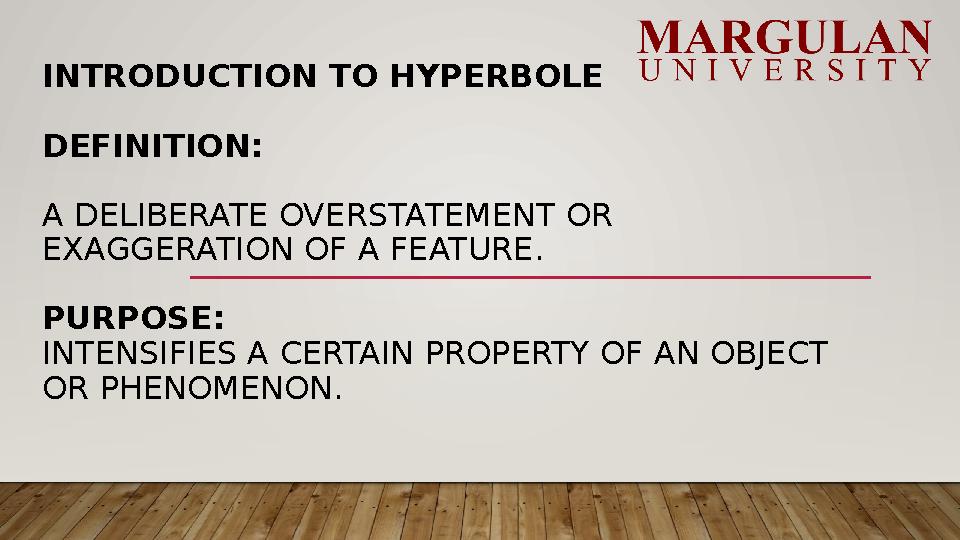
#3 слайд
INTRODUCTION TO HYPERBOLE
DEFINITION:
A DELIBERATE OVERSTATEMENT OR
EXAGGERATION OF A FEATURE.
PURPOSE:
INTENSIFIES A CERTAIN PROPERTY OF AN OBJECT
OR PHENOMENON.
3 слайд
INTRODUCTION TO HYPERBOLE DEFINITION: A DELIBERATE OVERSTATEMENT OR EXAGGERATION OF A FEATURE. PURPOSE: INTENSIFIES A CERTAIN PROPERTY OF AN OBJECT OR PHENOMENON.
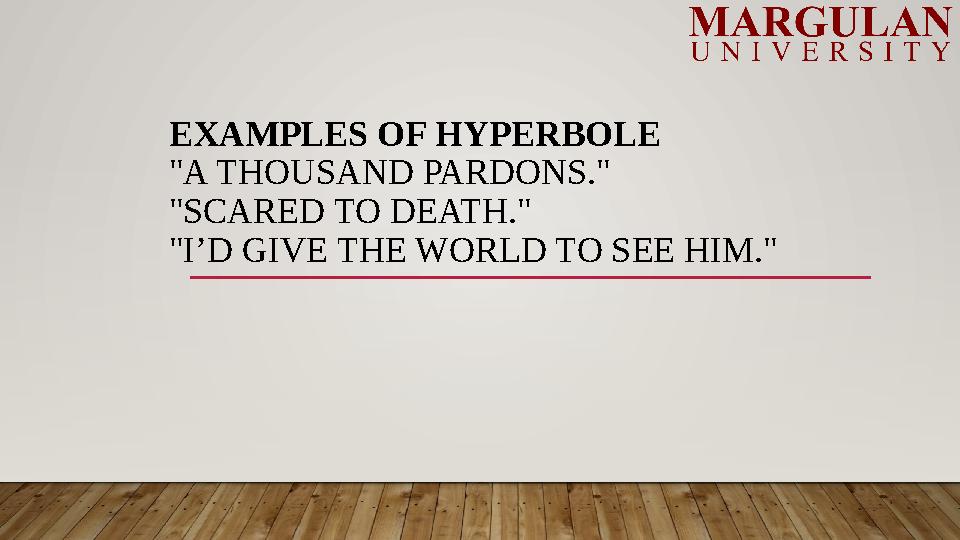
#4 слайд
EXAMPLES OF HYPERBOLE
"A THOUSAND PARDONS."
"SCARED TO DEATH."
"I’D GIVE THE WORLD TO SEE HIM."
4 слайд
EXAMPLES OF HYPERBOLE "A THOUSAND PARDONS." "SCARED TO DEATH." "I’D GIVE THE WORLD TO SEE HIM."
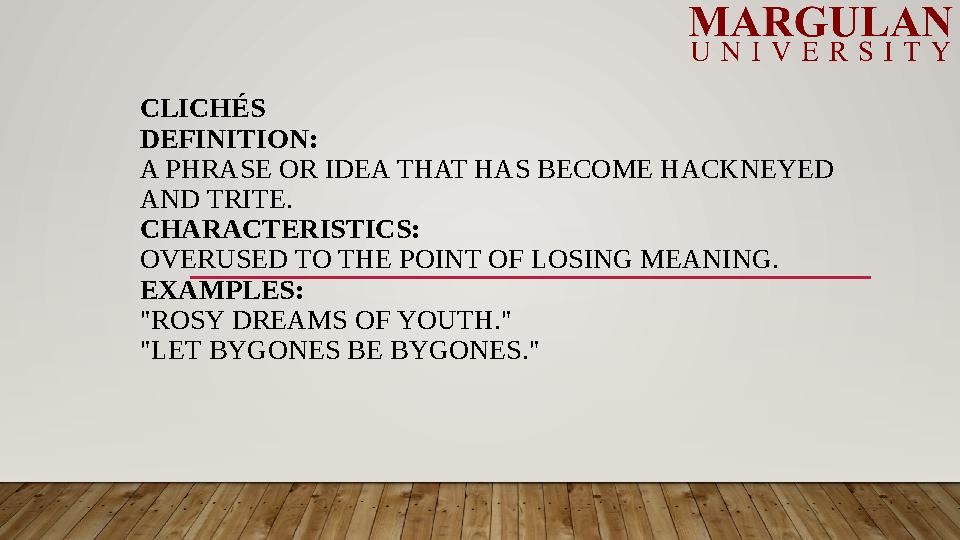
#5 слайд
CLICHÉS
DEFINITION:
A PHRASE OR IDEA THAT HAS BECOME HACKNEYED
AND TRITE.
CHARACTERISTICS:
OVERUSED TO THE POINT OF LOSING MEANING.
EXAMPLES:
"ROSY DREAMS OF YOUTH."
"LET BYGONES BE BYGONES."
5 слайд
CLICHÉS DEFINITION: A PHRASE OR IDEA THAT HAS BECOME HACKNEYED AND TRITE. CHARACTERISTICS: OVERUSED TO THE POINT OF LOSING MEANING. EXAMPLES: "ROSY DREAMS OF YOUTH." "LET BYGONES BE BYGONES."
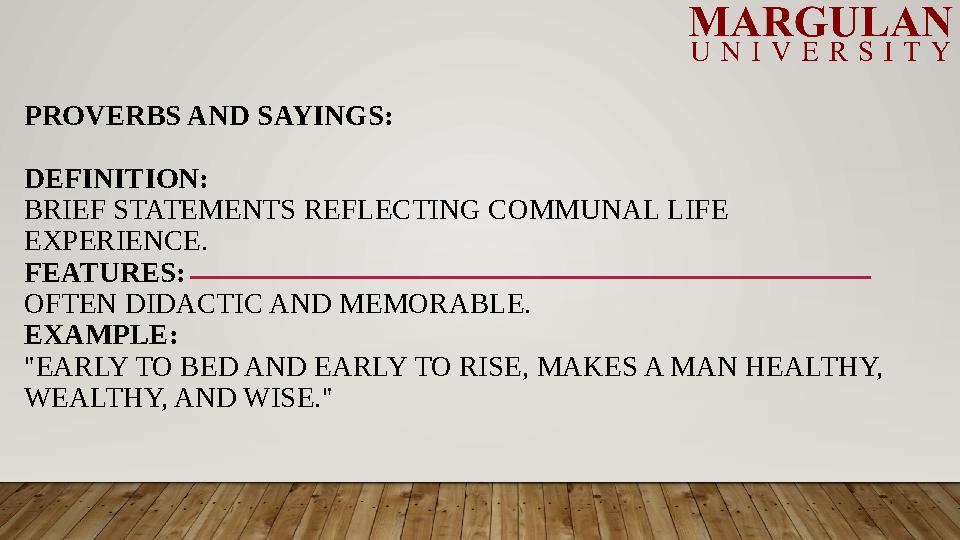
#6 слайд
PROVERBS AND SAYINGS:
DEFINITION:
BRIEF STATEMENTS REFLECTING COMMUNAL LIFE
EXPERIENCE.
FEATURES:
OFTEN DIDACTIC AND MEMORABLE.
EXAMPLE:
"EARLY TO BED AND EARLY TO RISE, MAKES A MAN HEALTHY,
WEALTHY, AND WISE."
6 слайд
PROVERBS AND SAYINGS: DEFINITION: BRIEF STATEMENTS REFLECTING COMMUNAL LIFE EXPERIENCE. FEATURES: OFTEN DIDACTIC AND MEMORABLE. EXAMPLE: "EARLY TO BED AND EARLY TO RISE, MAKES A MAN HEALTHY, WEALTHY, AND WISE."
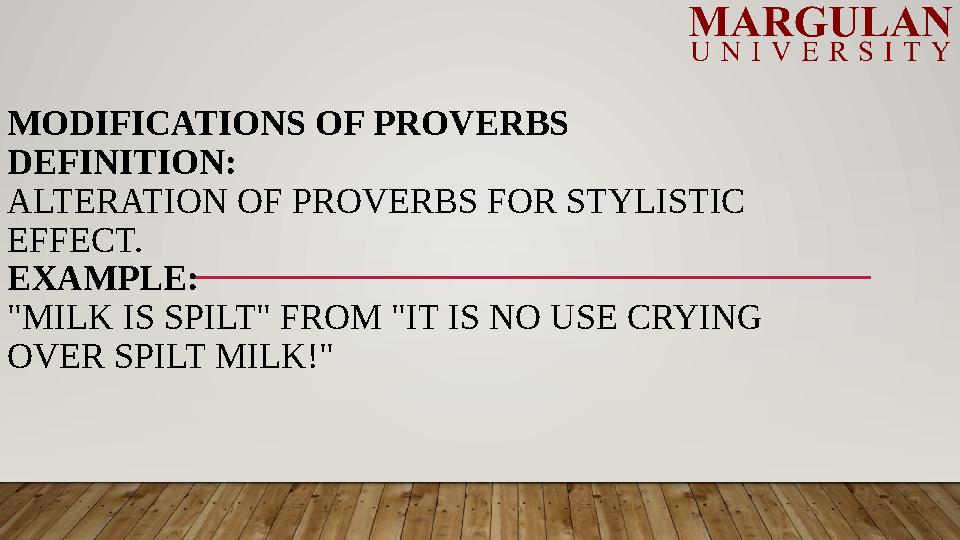
#7 слайд
MODIFICATIONS OF PROVERBS
DEFINITION:
ALTERATION OF PROVERBS FOR STYLISTIC
EFFECT.
EXAMPLE:
"MILK IS SPILT" FROM "IT IS NO USE CRYING
OVER SPILT MILK!"
7 слайд
MODIFICATIONS OF PROVERBS DEFINITION: ALTERATION OF PROVERBS FOR STYLISTIC EFFECT. EXAMPLE: "MILK IS SPILT" FROM "IT IS NO USE CRYING OVER SPILT MILK!"
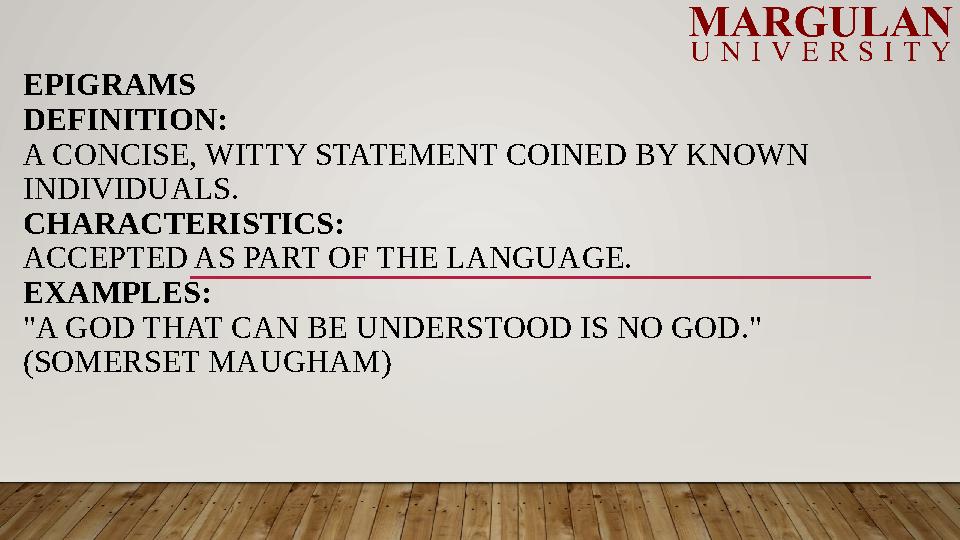
#8 слайд
EPIGRAMS
DEFINITION:
A CONCISE, WITTY STATEMENT COINED BY KNOWN
INDIVIDUALS.
CHARACTERISTICS:
ACCEPTED AS PART OF THE LANGUAGE.
EXAMPLES:
"A GOD THAT CAN BE UNDERSTOOD IS NO GOD."
(SOMERSET MAUGHAM)
8 слайд
EPIGRAMS DEFINITION: A CONCISE, WITTY STATEMENT COINED BY KNOWN INDIVIDUALS. CHARACTERISTICS: ACCEPTED AS PART OF THE LANGUAGE. EXAMPLES: "A GOD THAT CAN BE UNDERSTOOD IS NO GOD." (SOMERSET MAUGHAM)
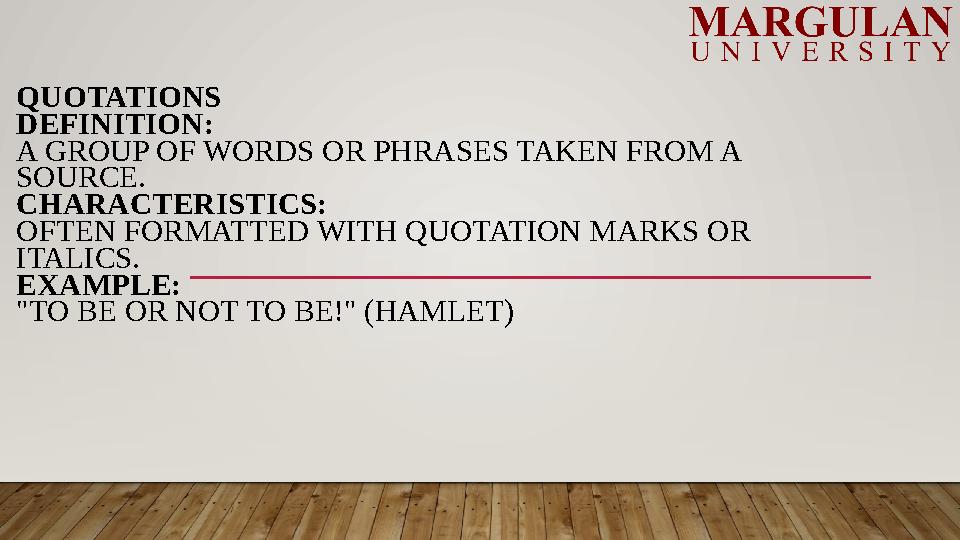
#9 слайд
QUOTATIONS
DEFINITION:
A GROUP OF WORDS OR PHRASES TAKEN FROM A
SOURCE.
CHARACTERISTICS:
OFTEN FORMATTED WITH QUOTATION MARKS OR
ITALICS.
EXAMPLE:
"TO BE OR NOT TO BE!" (HAMLET)
9 слайд
QUOTATIONS DEFINITION: A GROUP OF WORDS OR PHRASES TAKEN FROM A SOURCE. CHARACTERISTICS: OFTEN FORMATTED WITH QUOTATION MARKS OR ITALICS. EXAMPLE: "TO BE OR NOT TO BE!" (HAMLET)
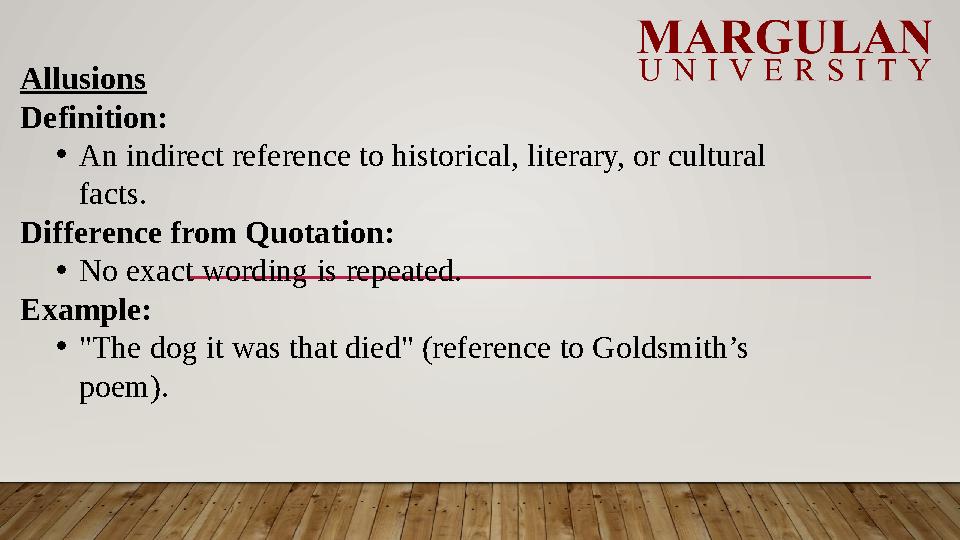
#10 слайд
Allusions
Definition:
•An indirect reference to historical, literary, or cultural
facts.
Difference from Quotation:
•No exact wording is repeated.
Example:
•"The dog it was that died" (reference to Goldsmith’s
poem).
10 слайд
Allusions Definition: •An indirect reference to historical, literary, or cultural facts. Difference from Quotation: •No exact wording is repeated. Example: •"The dog it was that died" (reference to Goldsmith’s poem).
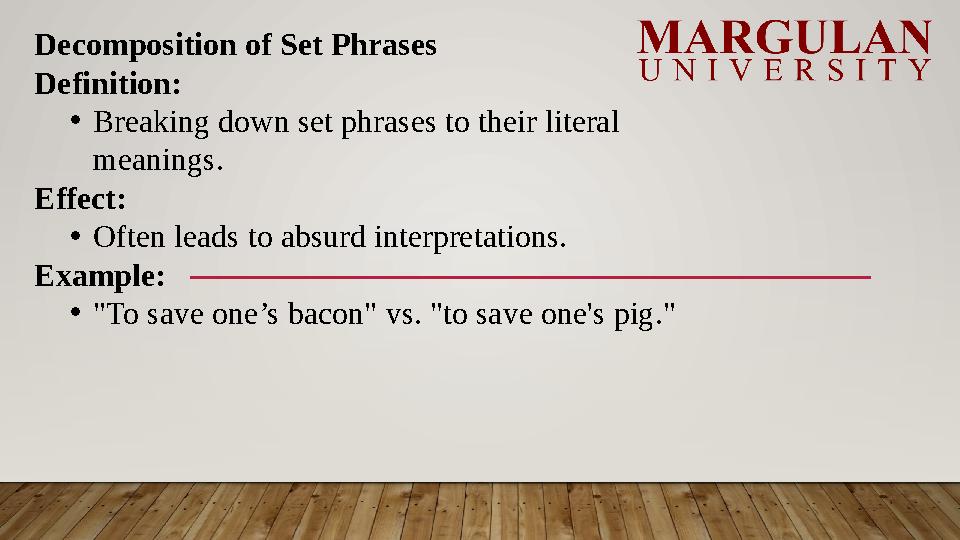
#11 слайд
Decomposition of Set Phrases
Definition:
•Breaking down set phrases to their literal
meanings.
Effect:
•Often leads to absurd interpretations.
Example:
•"To save one’s bacon" vs. "to save one's pig."
11 слайд
Decomposition of Set Phrases Definition: •Breaking down set phrases to their literal meanings. Effect: •Often leads to absurd interpretations. Example: •"To save one’s bacon" vs. "to save one's pig."
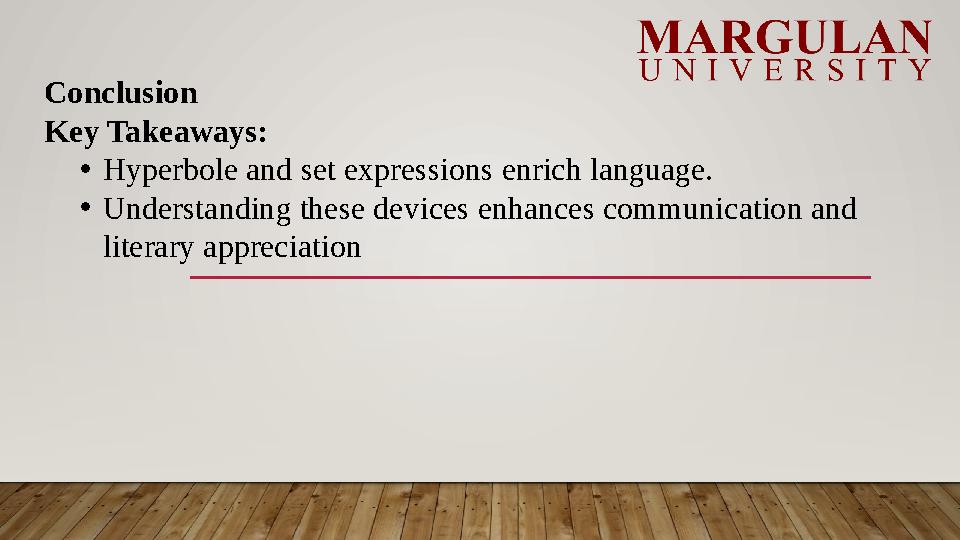
#12 слайд
Conclusion
Key Takeaways:
•Hyperbole and set expressions enrich language.
•Understanding these devices enhances communication and
literary appreciation
12 слайд
Conclusion Key Takeaways: •Hyperbole and set expressions enrich language. •Understanding these devices enhances communication and literary appreciation
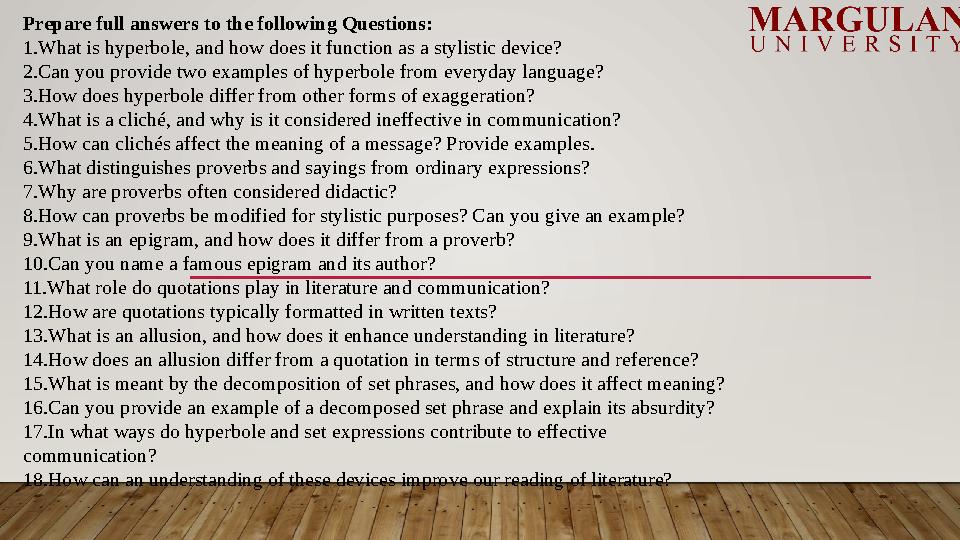
#13 слайд
Prepare full answers to the following Questions:
1.What is hyperbole, and how does it function as a stylistic device?
2.Can you provide two examples of hyperbole from everyday language?
3.How does hyperbole differ from other forms of exaggeration?
4.What is a cliché, and why is it considered ineffective in communication?
5.How can clichés affect the meaning of a message? Provide examples.
6.What distinguishes proverbs and sayings from ordinary expressions?
7.Why are proverbs often considered didactic?
8.How can proverbs be modified for stylistic purposes? Can you give an example?
9.What is an epigram, and how does it differ from a proverb?
10.Can you name a famous epigram and its author?
11.What role do quotations play in literature and communication?
12.How are quotations typically formatted in written texts?
13.What is an allusion, and how does it enhance understanding in literature?
14.How does an allusion differ from a quotation in terms of structure and reference?
15.What is meant by the decomposition of set phrases, and how does it affect meaning?
16.Can you provide an example of a decomposed set phrase and explain its absurdity?
17.In what ways do hyperbole and set expressions contribute to effective
communication?
18.How can an understanding of these devices improve our reading of literature?
13 слайд
Prepare full answers to the following Questions: 1.What is hyperbole, and how does it function as a stylistic device? 2.Can you provide two examples of hyperbole from everyday language? 3.How does hyperbole differ from other forms of exaggeration? 4.What is a cliché, and why is it considered ineffective in communication? 5.How can clichés affect the meaning of a message? Provide examples. 6.What distinguishes proverbs and sayings from ordinary expressions? 7.Why are proverbs often considered didactic? 8.How can proverbs be modified for stylistic purposes? Can you give an example? 9.What is an epigram, and how does it differ from a proverb? 10.Can you name a famous epigram and its author? 11.What role do quotations play in literature and communication? 12.How are quotations typically formatted in written texts? 13.What is an allusion, and how does it enhance understanding in literature? 14.How does an allusion differ from a quotation in terms of structure and reference? 15.What is meant by the decomposition of set phrases, and how does it affect meaning? 16.Can you provide an example of a decomposed set phrase and explain its absurdity? 17.In what ways do hyperbole and set expressions contribute to effective communication? 18.How can an understanding of these devices improve our reading of literature?

#14 слайд
Thank you for your attention!
14 слайд
Thank you for your attention!

шағым қалдыра аласыз



